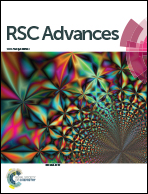Enhanced hydrophilicity of a thermo-responsive PVDF/palygorskite-g-PNIPAAM hybrid ultrafiltration membrane via surface segregation induced by temperature
Abstract
The hydrophilicity of a thermo-responsive PVDF/palygorskite-g-PNIPAAM hybrid ultrafiltration membrane was enhanced via surface segregation induced by coagulation bath temperature (CBT). The N1s content of the hybrid ultrafiltration membranes prepared at 5 and 20 °C is 1.77% and 1.02%, respectively while that of the membrane prepared at 40 °C is just 0.73%. This indicated that the PNIPAAM chains could be dragged to the membrane surfaces or pores via surface segregation induced by temperature. This resulted in higher hydrophilicity and permeability as well as thermo-responsiveness for membranes prepared at lower temperatures. The initial water contact angle of the PVDF/palygorskite-g-PNIPAAM hybrid ultrafiltration membrane prepared at 5 and 20 °C is 75.2° and 75°, respectively, which is about 6° lower than the one prepared at 40 °C. A higher pure water flux (PWF) of about 366 L m−2 h−1 at 40 °C was obtained for the hybrid membrane prepared at 5 °C while the one prepared at 40 °C only reached 274 L m−2 h−1. Meanwhile, membranes prepared at low temperature exhibited fewer macrovoids, lower membrane thickness and larger elongation.


 Please wait while we load your content...
Please wait while we load your content...